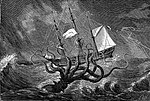 | All extant cephalopods have a two-part beak, or rostrum, situated in the buccal mass and surrounded by the muscular head appendages. The dorsal (upper)... 16 KB (1,920 words) - 01:09, 8 March 2024 |
 | A cephalopod /ˈsɛfələpɒd/ is any member of the molluscan class Cephalopoda /sɛfəˈlɒpədə/ (Greek plural κεφαλόποδες, kephalópodes; "head-feet") such as... 134 KB (14,932 words) - 18:06, 2 May 2024 |
echidnas and platypuses, which have a beak-like structure), sirens, pufferfish, billfishes and cephalopods. Although beaks vary significantly in size, shape... 83 KB (9,158 words) - 10:25, 17 March 2024 |
 | All cephalopods possess flexible limbs extending from their heads and surrounding their beaks. These appendages, which function as muscular hydrostats... 15 KB (1,255 words) - 09:01, 15 January 2024 |
refer to: Beak (bivalve), the oldest point on a bivalve mollusc's shell Beak (botany), a pointed projection on various plant parts Cephalopod beak, an 'inkfish'... 1 KB (180 words) - 05:02, 27 March 2024 |
officer, in the US Navy Upper reference limit Upper rostral length, of a cephalopod beak Urali language (ISO 639-3: url) University Ramon Llull, university... 694 bytes (120 words) - 04:04, 31 March 2024 |
 | in the chitin-protein complexes of the beak, pen, sucker disc, radula and oesophageal cuticle of cephalopods". Comparative Biochemistry and Physiology... 6 KB (390 words) - 23:25, 30 March 2024 |
Atlas of cephalopod distribution in the Southern Ocean". Antarctic Science 11:61-62. online version Xavier, J.C. & Y. Cherel (2009). "Cephalopod Beak Guide... 105 KB (6,675 words) - 20:32, 28 April 2024 |
 | Squid (category Cenozoic cephalopods) barnacles. Like all cephalopods, squids are predators and have complex digestive systems. The mouth is equipped with a sharp, horny beak mainly made of chitin... 67 KB (6,853 words) - 08:04, 8 April 2024 |
 | Argonaut (animal) (section Beak) gas-filled chambers present in chambered nautilus shells and is not a true cephalopod shell, but rather an evolutionary innovation unique to the genus. It is... 22 KB (2,036 words) - 23:46, 11 May 2024 |
 | Colossal squid (category Cenozoic cephalopods) this species. Studies measuring the δ15N content of the chitinous beaks of cephalopods to determine trophic ecology levels have demonstrated that the colossal... 34 KB (3,765 words) - 15:19, 3 May 2024 |
 | cuttlefish, and nautiloids. Like other cephalopods, an octopus is bilaterally symmetric with two eyes and a beaked mouth at the center point of the eight... 114 KB (11,963 words) - 17:25, 10 May 2024 |
 | Giant squid (category Cephalopods described in 1860) beak, as in other cephalopods.[citation needed] Giant squid have small fins at the rear of their mantles used for locomotion. Like other cephalopods,... 62 KB (6,565 words) - 14:34, 13 May 2024 |
Cameroceras (category Ordovician cephalopods of North America) been strong enough to breach the prey's exoskeleton or shell. Modern cephalopods beaks contain a radula, or 'toothed' tongue, which is used to rasp out soft... 21 KB (1,574 words) - 23:04, 21 April 2024 |
 | Naturelle (ser. 4)17(3–4): 307–343. Lu, C.C. & R. Ickeringill (2002). Cephalopod beak identification and biomass estimation techniques: tools for dietary... 401 KB (31,643 words) - 16:03, 2 May 2024 |
 | Giant Pacific octopus (category Cephalopods of North America) dofleini), also known as the North Pacific giant octopus, is a large marine cephalopod belonging to the genus Enteroctopus and Enteroctopodidae family. Its spatial... 43 KB (4,777 words) - 20:52, 10 May 2024 |
 | Cuttlefish (category Cenozoic cephalopods) between cuttlefish and almost all other cephalopods allows them to produce venom, excreting it through their beak to help kill their prey. Additionally... 56 KB (6,166 words) - 21:05, 1 May 2024 |
 | Seven-arm octopus (category Cephalopods of Oceania) include the blue shark, Hawaiian monk seal, sperm whale, and swordfish. Cephalopod size Allcock, L. (2014). "Haliphron atlanticus". IUCN Red List of Threatened... 9 KB (817 words) - 04:11, 6 May 2024 |
 | Ammonoidea (category Mesozoic cephalopods) Ammonoids are extinct spiral shelled cephalopods comprising the subclass Ammonoidea. They are more closely related to living coleoids (i.e., octopuses... 49 KB (5,527 words) - 23:25, 24 March 2024 |
 | pinniped diets: Accounting for complete digestion of otoliths and cephalopod beaks". Canadian Journal of Fisheries and Aquatic Sciences. 57 (5): 898–905... 26 KB (3,126 words) - 02:10, 11 May 2024 |
 | Poultry farming (section Beak trimming) acute and chronic pain. Severe beak trimming, or beak trimming birds at an older age, may cause chronic pain. Following beak trimming of older or adult hens... 64 KB (7,381 words) - 07:32, 29 April 2024 |









